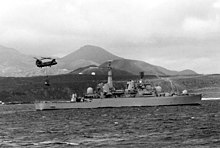Terence Lewin
Mentioned in Despatches (3) |
|---|
Born the son of Eric Lewin and Maggie Lewin (née Falconer)

In the Valiant he took part in the
Lewin attended the gunnery school at
Lewin was given command of the destroyer

Lewin was appointed
Lewin was the first Chief of Defence Staff to act as Head of the Armed Forces rather than just Chairman of the Chiefs of Staff Committee.[25] He was created a life peer, as Baron Lewin, of Greenwich in Greater London in October 1982[26] on his retirement.[25]
Later life
In retirement, Lewin became Chairman of the Trustees of the National Maritime Museum, President of the Society for Nautical Research, a Liveryman of the Skinners' Company and of the Shipwrights' Company and an elder brother of Trinity House.[27] His interests included military history: he was an expert on the life of Captain Cook.[8] He was appointed a Knight Companion of the Order of the Garter in April 1983.[25] He died at his home at Ufford in Suffolk on 23 January 1999.[25]
Family
In 1944, Lewin married Jane Branch-Evans; they had two sons and a daughter.[3]
Coat of Arms

|
Sinister: a Royal Marine, wearing the South Atlantic Medal proper. The whole upon a Compartment comprising a Grassy Mount with Outcrops of Rock proper, and having on each side a Sea Inlet barry wavy Argent and Azure.
|
References
- required.) (subscription required)
- ^ Heathcote, p. 155
- ^ a b c d e f g h i Heathcote, p. 156
- ^ "No. 35679". The London Gazette. 21 August 1942. p. 3719.
- ^ "No. 36676". The London Gazette (Supplement). 25 August 1944. p. 4010.
- ^ "No. 36794". The London Gazette (Supplement). 10 November 1944. p. 5224.
- ^ "No. 35805". The London Gazette (Supplement). 27 November 1942. p. 5226.
- ^ a b c "Obituary: Admiral of the Fleet Lord Lewin". The Independent. 25 January 1999. Archived from the original on 11 August 2022. Retrieved 30 August 2012.
- ^ "No. 38681". The London Gazette. 2 August 1949. p. 3760.
- ^ a b c d e f g Heathcote, p. 157
- ^ "No. 39749". The London Gazette. 9 January 1953. p. 220.
- ^ "No. 41450". The London Gazette. 18 July 1958. p. 4514.
- ^ "No. 41589". The London Gazette (Supplement). 30 December 1958. p. 5.
- ^ "No. 44365". The London Gazette (Supplement). 14 July 1967. p. 7881.
- ^ "No. 44405". The London Gazette (Supplement). 8 September 1967. p. 9891.
- ^ "No. 45214". The London Gazette (Supplement). 16 October 1970. p. 11458.
- ^ a b Heathcote, p. 158
- ^ "No. 45860". The London Gazette (Supplement). 29 December 1972. p. 2.
- ^ Hill, Lewin of Greenwich," 2012; Roberts, Safeguarding the Nation," 2009.
- ^ "No. 46138". The London Gazette (Supplement). 26 November 1973. p. 14081.
- ^ "No. 46919". The London Gazette (Supplement). 4 June 1976. p. 8016.
- ^ "No. 47173". The London Gazette (Supplement). 14 March 1977. p. 3571.
- ^ "No. 47904". The London Gazette (Supplement). 16 July 1979. p. 8998.
- ^ Heathcote, p.159; Stephen Prince "British command and control in the Falklands Campaign." Defense & Security Analysis 18.4 (2002): 333–349.
- ^ a b c d Heathcote, p. 159
- ^ "No. 49176". The London Gazette. 24 November 1982. p. 15347.
- ISBN 1 870520 19 X
- ^ Chessyre, Hubert (1994–1995). "The Heraldry of the Garter Banners" (PDF). Report of the Society of the Friends of St George's and the Descendants of the Knights of the Garter. VII (6): 254. Retrieved 19 January 2022.
Sources
- Heathcote, Tony (2002). The British Admirals of the Fleet 1734 – 1995. Pen & Sword Ltd. ISBN 0-85052-835-6.
- Rear-Admiral ISBN 978-0-304-35329-3.
- Prince, Stephen. "British command and control in the Falklands Campaign." Defense & Security Analysis 18.4 (2002): 333–349.
Further reading
- Finlan, Alastair. The Royal Navy in the Falklands Conflict and the Gulf War: Culture and Strategy (Psychology Press, 2004).

